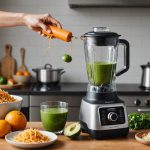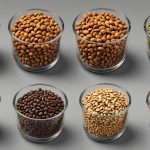The culinary world is full of innovative techniques designed to enhance the flavors and textures of your favorite meals. One such method is sous-vide cooking. It’s an intriguing approach that involves sealing food in a plastic bag and then cooking it in water at a precise temperature. The result? Food that’s cooked evenly and retains its juices, making every bite a delightful experience.
But what about vegetarian cuisine? Can a sous-vide machine be used for it? Well, you’d be surprised to find out that sous-vide cooking is actually a versatile technique that can perfectly complement vegetarian recipes. In this article, we will explore this concept in depth.
Additional reading : How to Select the Perfect Coffee Machine for a Small Office?
The Basics of Sous-Vide
Sous-vide, a French term that translates to "under vacuum", is a cooking method that’s been adopted by professional chefs worldwide. The technique involves placing the food item, be it meat, vegetables, or even dessert, in a vacuum-sealed bag. This bag is then immersed in a water bath and cooked at precise, low temperatures for extended periods.
While sous-vide is often associated with cooking meats to perfection, it is by no means limited to this. Vegetables can also benefit from sous-vide cooking, as the low and slow cooking process allows them to cook thoroughly without losing their shape or texture.
Additional reading : What Types of Containers Are Best for Freezer Storage?
Sous-Vide and Vegetables: A Match Made in Culinary Heaven
Vegetarian cuisine is all about bringing out the vibrant flavors and textures of fruits and vegetables. Sous-vide cooking does just that. When cooked sous-vide, vegetables retain their color, texture, and nutritional value. Unlike boiling or steaming, where nutrients can leach out into the water, sous-vide cooking allows vegetables to cook in their own juices.
The precise temperature control of sous-vide machines also ensures that your vegetables are cooked perfectly everytime. You don’t have to worry about overcooking your veggies and turning them into a mushy mess. With sous-vide, you can achieve the ideal texture – tender but still with a bit of crunch.
Exploring Sous-Vide Vegetarian Recipes
Vegetables are not the only vegetarian ingredients that you can cook sous-vide. Tofu, for instance, can turn amazingly tender and flavorful when cooked using this method. Even eggs, a staple in many vegetarian diets, can be cooked to perfection using a sous-vide machine.
A simple sous-vide vegetable recipe might involve cooking asparagus at 85°C for around 15 minutes. The result will be perfectly cooked asparagus that’s tender and full of flavor. For a more elaborate recipe, you could try a sous-vide ratatouille. Simply seal bell peppers, zucchini, eggplant, tomatoes, and onions in a bag with herbs and olive oil, and cook at 85°C for two hours. The result will be a flavorful and nutritious vegetable dish.
How to Sous-Vide Vegetables
Using a sous-vide machine to cook vegetables is not rocket science. It’s a relatively straightforward process. First, you’ll need to preheat your water bath to the desired temperature. Once the water has reached the right temperature, place your vegetables in a vacuum-sealed bag and drop it into the water.
The cooking time will depend on the type of vegetable and the desired level of doneness. As a general rule, most vegetables can be cooked at a temperature range of 85°C to 87°C for about 30 to 45 minutes. However, denser vegetables like potatoes or carrots might need more time. You might have to experiment a bit to find the perfect cooking time and temperature for your favorite veggies.
The Advantage of Sous-Vide Cooking for Vegetarian Cuisine
One of the main advantages of sous-vide cooking for vegetarian cuisine is the ability to retain the nutritional value of the food. By cooking in a sealed bag, the nutrients are preserved within the food, rather than being lost to the cooking water as in traditional boiling or steaming methods.
Additionally, sous-vide cooking allows for better texture control. Whether you prefer your vegetables a bit crunchy or you like them really soft, you can achieve the desired texture by adjusting the cooking time and temperature. Plus, the flavors are intensified because they are sealed within the bag and not diluted in water or steam.
In conclusion, sous-vide cooking is not just for meat-lovers. It’s a versatile cooking method that can add a new dimension to vegetarian cuisine. So, yes, a sous-vide machine can most definitely be used for vegetarian cooking. Whether you’re a professional chef or a home cook, incorporating sous-vide cooking into your vegetarian recipes will take your dishes to a whole new level.
Additional Vegetarian Ingredients for Sous-Vide Cooking
There is a vast array of vegetarian-friendly options that you can cook using a sous-vide machine. Apart from basic vegetables, you can experiment with ingredients like tempeh, seitan, and various types of cheese to introduce more variety into your meals. You can also use the sous-vide method to infuse flavors into olive oils or to make creamy, perfectly textured custards and yogurts.
A sous-vide eggplant, for instance, would be a delight. You could cook it at 85°C for about 30 minutes. The result will be a perfectly tender eggplant, ideal for a vegan eggplant parmesan. Vide fennel is another fantastic option. Cooking it at 85°C for about 40 minutes sous-vide will yield a tender and flavorful result, perfect for salads or side dishes.
Sous-vide cooking is also great for vegan sous-vide recipes. You can cook tofu or tempeh at precise temperatures to achieve desired textures. For a flavorful vegan meal, consider marinating your tofu or tempeh in your favorite sauces or herbs before sealing in a sous-vide bag and cooking. The sealed bag ensures that the flavors are absorbed directly into the food, making each bite an amazing food experience.
The Conclusion: Sous-Vide for Vegetarian Cooking
In the realm of modern cooking techniques, sous-vide cooking stands out as one of the most versatile and effective methods for preparing a wide range of dishes, including vegetarian and vegan meals. The precise control over temperature that sous-vide cooking offers allows you to cook vegetables and other vegetarian ingredients to perfection, every single time.
Whether you’re preparing vide vegetables, making a vide vegetable recipe, or even trying something more exotic like sous-vide eggplant or vide fennel, you’ll find that this method brings out the best in your ingredients. The flavors are more intense, the textures are better, and the nutritional value is preserved.
Moreover, sous-vide cooking is not overly complex. With a good sous-vide machine, a water bath, and a vacuum sealer, you’ll have all that you need to get started. You arrange your ingredients in a single layer in the vide bag, seal it, set the right temperature on the sous-vide machine, and then let the water bath do its magic.
So, yes, a sous-vide machine can indeed be used for vegetarian cooking. It’s a worthy investment that can take your vegetarian or vegan cuisine to a whole new level. The possibilities are almost endless, and the results are always impressive. So why not give sous-vide cooking a try? You might just discover a new favorite cooking method.











